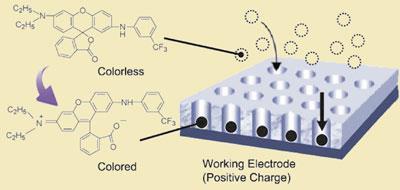A new nano-structured approach to creating electronic paper devices could produce clearer images
Nanostructured materials have been used by Japanese researchers to make electronic displays that have some of the highest levels of reflectance yet seen. The advance could lead to low cost e-paper capable of displaying images more clearly than current technology.
’The new structure, which reduces drift of image, has the advantage of clearer and faster imaging,’ says Yusuke Yamauchi of the National Institute for Materials Science in Ibaraki, who led the team. The researchers employed an electrochromic system, based on materials that change their colour intensity when a current is applied - in this case, a colourless leuco dye that donates electrons to a positive electrode and turns black.
What keeps the reflectance high is the titanium dioxide coating on the electrode, which is structured with tiny vertical channels that stop the dye molecules from drifting. So where the dye molecules are colourless, the pixels appear white - because the background material is white - and because they don’t drift, the display appears very clear.

’They have reflectivities of 80 or 90 per cent - the highest I’ve ever seen from a reflective display technology or an e-paper type of technology,’ says Cliff Jones, chief technical officer and co-founder of ZBD, which makes e-paper for electronic shelf labels. He thinks the technology could be applied in producing lower cost e-paper displays. Although, he adds, the methods they are using aren’t suitable for large scale manufacture.
As Yamauchi explains, the devices are currently produced in water solution at room temperature. The cost implications, he says, are ’not clear at this stage of development’ as there are no similar devices in mass production, but he believes production costs will be ’moderate’.
The team’s leuco dye system works at high speeds compared to other electrochromic sytems, which have previously used various polymers or catenanes but switch very slowly. Yamauchi says their system can achieve even faster display speeds by optimising the diameter and depth of the channels.
They also claim they can realise full colour displays using leuco dyes - Yamauchi suggests two or three layers of different colours could be combined. But Jones thinks it may be practically simpler and cheaper to use colour filters. Most companies that produce electronic paper technologies, including E-ink, which dominates the e-book market, currently use this approach to keep manufacturing costs down.
Hayley Birch
References
et alAngew. Chem. Int. Ed., 2010, DOI: 10.1002/anie.200907008






No comments yet